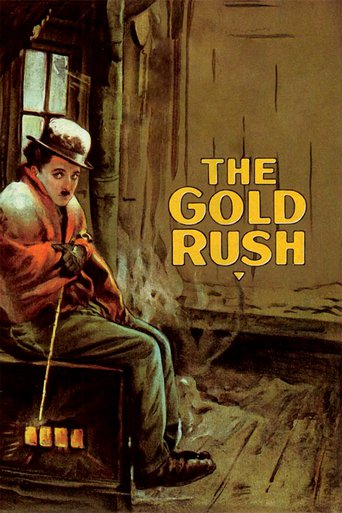

Big Jim, a gold prospector during the Klondike Gold Rush, has just found an enormous gold deposit on his parcel of land when a blizzard strikes. The Lone Prospector gets lost in the same blizzard while also prospecting for gold. He stumbles into the cabin of Black Larsen, a wanted criminal. Larsen tries to throw him out when Jim also stumbles inside. Larsen tries to scare both out using his shotgun but is overpowered by Jim and the three agree to an uneasy truce where they all can stay in the cabin.When the storm is taking so long that food is running out, the three draw lots for who will have to go out into the blizzard to obtain some food. Larsen loses and leaves the cabin. While outside looking for food, he encounters Jim's gold deposit and decides to ambush him there when Jim returns.
... View MoreThe gold rush, an early work from Chaplin after "The Kid". This one, integrally one of the most humorous and lightest. A story of a tramp's adventure to a mountain. He meet so many things in the trenches, bear, hunter, and of course a romance, which Chaplins best at. In this masterpiece, which Chaplin prevalent made, consist one of the best performance by the exalted Chaplin. A performance at the dinner, yeah guys, these dancing bread !! Nowadays, you can't call it as acting, we call it as pure talent.Prevailing habits of the audience while witnessing another Chaplin, the feelings of another inspiration, another humanity, another huge applause, and of course another cry. I never understand why he always successfully did it, such a prosperous masterpiece maker. We don't talk about ecclesiastical or pious on Chaplins. He was secular but as triumphant humanism, noble as film-maker. Chaplin is a generous elite that dare and care to us, the next generation. He taught us so many universality which distilled by every scenes within silence. Maybe haunting the viewers with his creation was his hobby. Bring the reconciliation after fights, bring the light after darkness, and bring a smile after sadness, that was Chaplin could do. That was proved for every generation whose already watch his creations. Thank you Chaplin.. from your biggest fan.. 23 years-old boy..
... View MoreThis movie will always have a special place in my heart. This was the first 'long' feature film made by Charlie Chaplin that I saw and the first time I got to see his familiar gags (like the Tramp eating his shoe or 'the dance of the rolls') in context. It surpassed all my expectations and left me speechless.For today's audiences a black-and-white silent film may seem hopelessly outdated, but The Gold Rush is truly a timeless masterpiece that has remained just as fresh, funny and moving as it once was. It's incredibly imaginative, wonderfully structured, and despite the countless laugh-out-loud burlesque moments, it's surprisingly poetic and tear-inducing. It is very reminiscent of Woody Allen's best bittersweet comedies (of course, Allen being an admirer of Chaplin's work, it's actually the other way round), so if you like Woody's perspective (and maybe enjoyed films like Zelig or Manhattan – shot in black-and-white - from Allen's vast catalogue), The Gold Rush is highly recommended to see where he is coming from.If it's just that you have never been brave enough to attempt a silent feature, well, The Gold Rush is the perfect starting point. May it be your first step into a larger world.
... View MoreThe Gold Rush is a film that shows Charlie at both his comedic and heart string pulling best, proving that hunkering down in an isolated cabin with a murderer while a snow storm rages outside is in fact a great situation for comedy. Back in town he falls for a woman named Georgia and pulls all the romantic strings - dancing with her whilst using the lead of a dog as a belt to hold up his trousers, entertaining her at the dining table using forks and bread as dancing feet (in his dreams), and after receiving a love letter, venturing back out into the wilderness to claim a mountain of gold for the two of them. However little did he know that the letter was intended for another man, and the dance was only an escape from one. The poor little tramp who can hardly catch a break and only had one shoe to wear after his other was eaten in a severe state of hunger, was being played the whole time.The story relies on quite a few coincidences and loose plot threads, and as you can imagine, leans very strongly on the edges of unbelievability. This is all easily forgivable for the first two acts, as the quality of gags is so entertaining that looking for continuity seems beside the point. Unfortunately however the third act, which sees the cabin Charlie and his mate are sleeping in blown precariously close to the cliffs edge, and the forgotten landmark of gold, really does push too far against those edges, and metaphorically shall I say, falls over the cliff. I guess it was done for the sake of metaphor - a visual of his life literally being on the brink of disaster - but the quality of gags here are not nearly as good as those that came beforehand, and Charlie was always better at gags than metaphor anyway. The chance (did I mention the story relies on coincidences?) encounter between Georgia and Charlie on the boat is even more awkward. With he now a millionaire, the two appear set to live happily ever after, but is it really happy if she is so undeserving?It is well worth watching however, as the first two acts contain some great material.
... View More